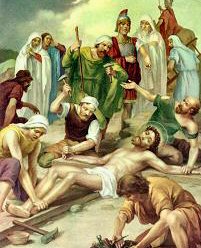Lent: March 15th
Tuesday of the Fifth Week of Lent
Other Commemorations: St. Louise de Marillac, Widow (RM)
» Enjoy our Liturgical Seasons series of e-books!
"When you have lifted up the Son of Man, then you will know that I am he." All the world's hatred and suffering are the results of sin, original or personal. To restore all things to love and order and joy, Jesus atoned for sin by His death and won the grace that effects forgiveness. His indwelling life is the basic sanctity of Christians, to be developed into acquired splendor. — Daily Missal of the Mystical Body
Before the reform of the Roman Calendar, this was the feast of St. Louise de Marillac. She was born in 1592, and married in 1613. When her husband died she made a vow of widowhood and devoted herself entirely to works of charity. St. Vincent de Paul, who became her spiritual director, gradually initiated her into his own charitable works for the poor and afflicted, and in 1639 they founded the Congregation of the Daughters of Charity to which St. Louise dedicated the rest of her life. She was canonized by Pope Pius XI on March 11, 1934.
St. Louise de Marillac
 St. Louise de Marrillac married an official of the royal court, Antony Le Gras, and after his death in 1625 was an active supporter of the charitable work of St Vincent de Paul, who came to put more and more reliance on her. Mademoiselle Le Gras, as she was known, became the co-founder with him of the Daughters of Charity, whose 'convent is the sick-room, their chapel the parish church, their cloister the city streets'; it was she who drew up the first draft of their rule of life. Her clear intelligence and wide sympathy played a big part in the beginnings of the congregation, whose aspirants she trained and whose rapid growth involved responsibilities which largely fell on her. At the time of her death there were already over forty houses of the sisters in France, the sick poor were looked after at home in twenty-six Parisian parishes, hundreds of women were given shelter, and there were other undertakings as well. St Louise was not physically robust, but she had great powers of endurance, and her selfless devotion was a source of incalculable help and encouragement to Monsieur Vincent.
St. Louise de Marrillac married an official of the royal court, Antony Le Gras, and after his death in 1625 was an active supporter of the charitable work of St Vincent de Paul, who came to put more and more reliance on her. Mademoiselle Le Gras, as she was known, became the co-founder with him of the Daughters of Charity, whose 'convent is the sick-room, their chapel the parish church, their cloister the city streets'; it was she who drew up the first draft of their rule of life. Her clear intelligence and wide sympathy played a big part in the beginnings of the congregation, whose aspirants she trained and whose rapid growth involved responsibilities which largely fell on her. At the time of her death there were already over forty houses of the sisters in France, the sick poor were looked after at home in twenty-six Parisian parishes, hundreds of women were given shelter, and there were other undertakings as well. St Louise was not physically robust, but she had great powers of endurance, and her selfless devotion was a source of incalculable help and encouragement to Monsieur Vincent.
—Dictionary of Saints by Donald Attwater.
Patronage: disappointing children; loss of parents; people rejected by religious orders; sick people; Christian Social Workers (proclaimed on 12 February 1960 by Pope John XXIII); Vincentian Service Corps; widows
Symbols and Representation: widows' clothing; Saint Louise is depicted wearing the original Vincentian habit of grey wool with a large headdress of white linen (typical of poor women in 17th century Brittany), perhaps with an infant in her arms.
Highlights and Things to Do:
- Read more about St. Louise:
- Teach your children this simple morning aspiration by St. Louise: "Grant me the grace to spend this day without offending You and without failing my neighbor."
- Daughters of Charity of St. Vincent de Paul which she helped found.
- St. Louise's remains are enshrined in the Chapel of the Miraculous Medal in the motherhouse of the Daughters of Charity in Paris. Her body is not incorrupt, but rather the body in the chapel is actually a wax effigy, containing her bones.
- Begin planning a family Passion presentation or play in which all can participate. You may want to plan this for the end of Lent — Spy Wednesday or Holy Thursday would be particularly appropriate days for this.

Friday of the Fourth Week of Lent
Station with Sant'Eusebio all'Esquilino (St. Eusebius in Esquiline):
Ancient church dedicated to St Eusebius of Vercelli, 4th century bishop. The church was financed by St. Eusebius of Bologna, and is first mentioned in 474. This means that it's one of the oldest churches in Rome; it was one of the first parish churches known as the Titulus Eusebi.
For more on Sant'Eusebio all'Esquilino, see:
For further information on the Station Churches, see The Stational Church.







